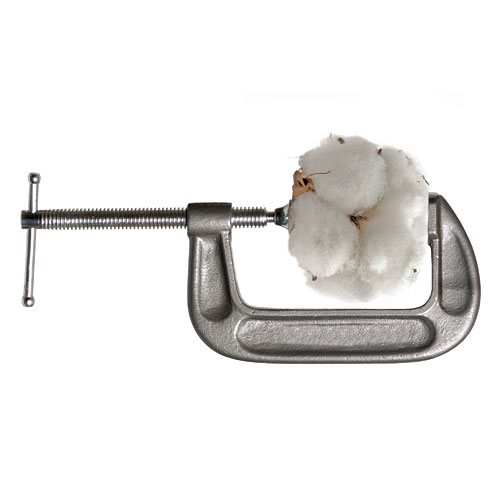It may be the fabric of our lives, but for children’s manufacturers and retailers feeling the pinch of skyrocketing costs, cotton has become the hassle of our lives. Prices on the traditionally affordable fabric have more than tripled in the past year, hitting a historic high of $2.30 per pound in mid-February. Although prices have […]
It may be the fabric of our lives, but for children’s manufacturers and retailers feeling the pinch of skyrocketing costs, cotton has become the hassle of our lives. Prices on the traditionally affordable fabric have more than tripled in the past year, hitting a historic high of $2.30 per pound in mid-February. Although prices have since dipped, analysts predict the fabric will remain expensive for the foreseeable future. With the industry still shaken from the recession, manufacturers and retailers report that the exorbitant costs have altered the way they do business— from more blends to flimsier fabric—and undermined their bottom lines.
What’s causing the spike? Experts say a combination of factors, from China’s rapidly expanding middle class and subsequent growing demand, to weak crops across the globe, caused by flooding in Pakistan and Australia and freezing weather in China. Some industry leaders surmise that while other factors were to blame at the beginning, speculation is playing a large role now. “What is frustrating is that we consider this continuous rise to be purely speculative at this point,” confirms Roxana Castillo, owner of infant clothing company Tatiana & Company, makers of Kissy Kissy. “Yes, there were real reasons for prices to have gone up at the beginning, but not to the level they’re at now.”
Manufacturers feeling the squeeze of high cotton costs say they have no choice but to raise their prices, and the pain is now being felt at the retail level, where the increases are appearing in the Fall ’11 collections merchants are currently purchasing. “I would say I buy 20 different vendors and about 12 of them went up,” says Ariena Thomsen, owner of Thank Heaven children’s boutique in Forest Hills, NY. “Sweaters I used to pay $26 for are now $29.” Cynthia Radoczy, owner of Manhattan-based children’s boutique Space Kiddets, estimates that about a quarter of the brands she carries have raised their prices. “I can see that my outerwear in quite a few cases is going to be less expensive than a little cotton dress,” she says.
Some retailers are coping with escalating costs by switching to brands with already low prices. Derrick Veillon, president of children’s manufacturer Paty, Inc., says the company was “careful to get a lot of feedback” and found that their relatively low prices, at $3 to $15, meant they had more flexibility when it came to increases. “That was the feedback we got from the reps and all of our customers,” Veillon notes. “Everybody else was going up, and it wasn’t going to hurt us to go up.” But children’s retailers who carry traditionally more expensive organic and European items—where increases have been particularly steep—may not have that option.
Aside from the challenge of climbing prices, children’s retailers must now face an apparel landscape increasingly dotted with a mix of blends—from polyester to rayon—as manufacturers switch to lower-priced fabrics to cope with the exorbitant cost of cotton. New Jersey children’s manufacturer Les Tout Petits’ owner Danny Letzt confirms that his company, “basically dropped doing business with cotton,” addingthat, “We used to do 80 percent in cotton and 20 percent in other fabrics, now it’s 90 percent in other fabrics and 10 percent in cotton.” Without blends, however, prices might reach beyond families’ budgets, many retailers note. Plus, some parents prefer wrinkleresistant blends, especially in boys’ wear, says Knuckleheads owner Melissa Nash. “Parents don’t want to be ironing their boys’ shirts all day long,” she points out.
Blends, though, can sometimes be a dirty word in the children’s industry, where cotton is perceived as a softer, more kid-friendly fabric. “From a retail standpoint people are noticing a major increase in the use of polyester and they hate it,” says Jamara Ghalayini, owner of Pumpkinheads children’s boutique in Brentwood, CA. Radoczy agrees: “I noticed that the lines that used to have very nice quality fabrication in cotton have lessened it, or they’re using other blends, like nylons. In my store, people don’t really like blends,” she adds. However, she believes people will eventually accept them, especially the ones that aren’t as apparent at first glance.
But for some parents, switching to blends simply isn’t an option, and 100-percent cotton is a necessity at whatever cost, Radoczy notes. “There are kids who are very sensitive to a lot of fabrics, so if the fabric is a poly or not 100-percent cotton, they’re going to find it itchy or maybe get a rash. In that case, I’m thinking that mom will be forced to pay a higher price to make her child comfortable,” she explains. Stacie Fox, owner of Nevada-based Sage Creek Organics, reports that her cotton prices have increased by as much as 50 percent for some of her items, but she’s committed to sticking to the company’s core mission instead of switching to blends or lightweight fabrics. “We are a certified organic cotton brand. We will not sacrifice quality for quantity,” she affirms.
In addition to incorporating blends, many children’s manufacturers are also dropping fabric weights on cotton products—leading to more headaches at the retail level. “In the tween department, they’ve been offering T-shirts that they call ‘burnout,’ which are almost see-though,” Radoczy says. “Those T-shirts that were very thin to begin with are even thinner now. They’re tissue,” she adds. Ghalayini says some of the shirts she ordered were “literally sheer” when they arrived and went straight on discount. “We’ve had more returns on that type of casual playwear this year, on very lightly used garments,” she says. “If it catches on anything, there’s a hole.”
Due to the increased volume of returns and dissatisfiedshoppers, Radoczy says the key to keeping customers coming back is good communication. “I’m trying to educate my customers now as they’re buying their spring goods; I’m giving them a little preparation of what to expect for the fall,” Radoczy says. But Thomsen at Thank Heaven is not so confident that customers will accept higher prices. “I just don’t think customers get it. I don’t think they understand how expensive it is for us to buy stuff. They hear that everything is so cheap to make,” she says. “It’s going to be a learning curve for the consumer,” concedes Priscilla Hunt, vice president of marketing for New ICM, a Texas-based children’s sleepwear manufacturer that was forced to raise the prices of some of their cotton underwear products. “It’s a hard thing to take, but I think they will at least understand why.”
Communication is especially important, industry experts note, since very few manufacturers and retailers expect prices will return to pre-inflation levels. Nikoleta Panteva, a retail analyst for market research firm IBISWorld, confirms that cotton costs will begin creeping back down by the end of this year, but the fiber is not expected to drop significantly—meaning higher prices may be the new normal for everyone from manufacturers to consumers. “We forecast a 16 percent decline in world cotton prices over 2012,” Panteva says.
How to survive the escalating costs? Both manufacturers and retailers agree the solution is sticking together to share the burden of high fabric prices, while passing as little on to the consumer as possible. “There is no way that any manufacturer can pass the increase onto their customer,” Fox says. “If so, you will put that retailer out of business. We all have to take a shared responsibility in helping each other,” she says. Hunt agrees that pairing up is important: “I think it’s going to take the retailers and the manufacturers working hand in hand and trying to partner as long as they can and still turn a profit.” —Audrey Goodson




Leave a Comment: